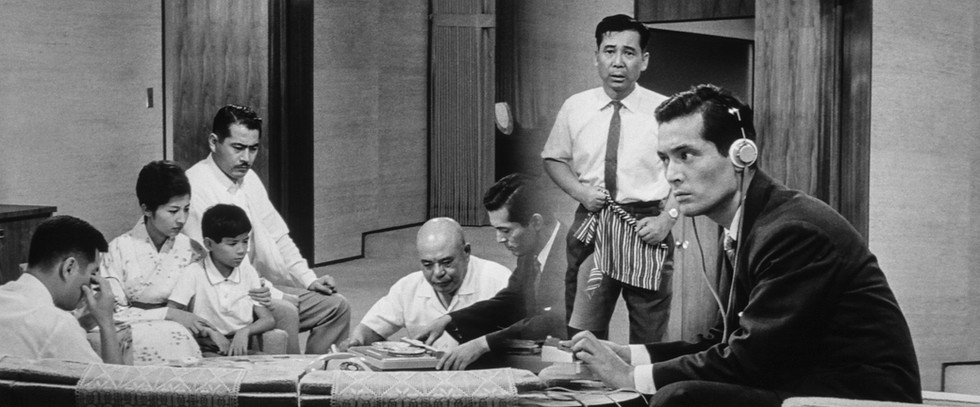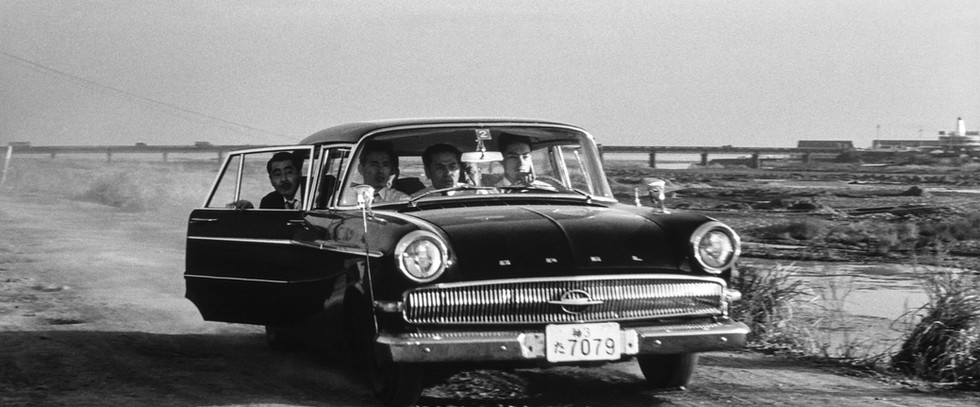Making a list? Add Akira Kurosawa’s masterful ‘High and Low’ to it
- Craig Shapiro
- Sep 29
- 6 min read
4K ULTRA HD REVIEW / SDR SCREENSHOTS
Toshiro Mifune, left, is King Gondo, a shoe company executive whose son is apparently kidnapped and held for a ransom of 30 million yen. Natusya Nakadai, right, is Inspector Tokura, the police officer in charge of the case.
(Click an image to scroll the larger versions)
“HIGH AND LOW: THE CRITERION COLLECTION”
4K Ultra HD & Blu-ray, 1963, unrated, mild language, Japanese with English subtitles
Best extra: “Between Heaven and Hell,” the 2008 essay by author Geoffrey O’Brien
IN HIS MUST-READ essay included on this must-have Criterion release, author Geoffrey O’Brien writes that having adapted Dostoevsky (“The Idiot”), Shakespeare (“Throne of Blood”) and Gorky (“The Lower Depths”), Akria Kurosawa was seen at home and abroad as the most “Western” of Japanese directors.
Kurosawa, however, always saw himself as purely Japanese, and you could hardly ask for a better example than his masterful “High and Low.” Rather than adapting a European classic, he drew on Ed McBain’s American crime thriller “King’s Ransom,” and instead of creating a period piece, he set it in modern-day Japan.
“He used it not to illuminate a vanished epoch but to produce a map of contemporary Japan that ranges from the complacent and affluent ‘heaven’ to the needy and nihilistic ‘hell’ of the film’s Japanese title,” O’Brien writes. He also includes a quote from Kurosawa, whose first trained as an artist: Since at least 1954’s “Seven Samurai,” “[I] tried to add my sensitivity as a painter to what I hoped was my increasing know-how as a filmmaker.”
(1&2) Gondo listens as the other directors of National Shoes, their eyes on higher profits and not higher quality, try to convince him to join them in a takeover bid. (3&4) They prepare to leave after being angrily dismissed by Gondo, then tempt his right-hand man Kawanishi (Tatsuya Mihashi, left) with a position in the proposed company.
Again, you could hardly ask for a better example. Using the widescreen lens like a paintbrush, Kurosawa “revels in the geometric play permitted by the ratio” while, working again with cinematographers Asakazu Nakai and Takao Sato (“Ran”), he constantly changes designs, employs multiple angles and “freely cuts in an out of different spatial planes.”
Remade by Spike Lee for the recent “Highest 2 Lowest,” “High and Low” also draws its considerable power from the performance of the great Toshiro Mifune. He plays King Gondo, an executive at National Shoes who is thrown into a moral dilemma when his son is kidnapped —but it’s not his son being held, it’s the son of his widowed chauffeur Aoki (Yutaka Sada). No matter, the kidnapper, a medical intern named Takeuchi (Tsutomo Yamazaki), tells Gondo he still must pay 30 million yen or the boy will die. Far removed from his definitive roles in “Seven Samurai,” “Yojimbo” and too many others to list here, Mifune’s restrained performance is remarkable.
Gondo, who has staked his fortune on a potential takeover of National Shoes, initially refuses. It’s here where Kurosawa departs from McBain’s premise; instead, he examines the class differences in 1960s Japan while calling attention to the “trickle-down psychological and physical damage wrought on those who live beneath the indifferent heel of their social betters,” Jake Cole wrote in Slant.
The police procedural in the film’s second half is also a master class. As Inspector Tokura (Tatsuya Nakadai), Head Detective “Bos’n” Taguchi (Kenjiro Ishiyama) and their team methodically track down the kidnapper, the tension builds and builds. You can’t help but being swept up.
Credit the other members of the cast, too. Every character is fully fleshed out out, including Kyoko Kagawa as Gondo’s wife Reiko, Tatsuya Mihashi as his turncoat right-hand man Kawanishi, Masahako Shimazu as the kidnapped Shin’ichi Aoki, and Jun Tazaki, Nobuo Nakamura and Yunosuke Ito, as the National Shoes executives who, eyeing profits rather than quality, want Gondo to join them in their own takeover bid.
(1) Gondo's son Jun (Toshio Egi, right) and Shin’ichi (Masahako Shimazu), son of the chauffeur Aoki, are ready to go outside and play. (2&3) The kidnapper tells Gondo and his wife Reiko (Kyoko Kagawa) that their son has been taken, but they soon realize that it is Shin’ichi who is being held. (4) Tokura and his team try to trace the kidnapper’s call. (5) Gondo is in the shower when the kidnapper calls again. (6) Upset by Shin’ichi’s kidnapping and her husband’s refusal to pay the ransom, Reiko has retreated to her room.
VIDEO/AUDIO
“High and Low” was remastered in 4K UHD from the 35mm original black and white camera negative by Tokyo Lab Ltd. Their meticulous handiwork speaks for itself: Even without HDR toning, the grayscale balance is smooth and detailed, from highlights to mid tones and shadows. Grain is also much more refined. Textures in Gondo’s mansion on the hill are sharp and the cityscape, seen in blinding sunlight from the home’s huge windows, is never washed out. Nothing is lost when the camera moves to Takeuchi’s squalid apartment and the teeming city streets. Subtitles are easy to read.
The 4.0 surround DTS-HD Master Audio soundtrack, picked up from Criterion’s 2011 Blu-ray, deftly balances the ambient noises and crystal-clear dialogue.
EXTRAS
As advertised, O’Brien’s essay tops the list. Incisive and in-depth, it’s a must not only for fans of Kurosawa, but anyone who appreciates fine writing.
Also good are two archival interviews, one with Mifune from a 1981 Japanese television broadcast and the other with Yamazaki recorded by Criterion in 2008. While Mifune does talk briefly about his early, early roles for Kurosawa, the interview gives you a real feel for the man described by the host as “the pride of Japan.” He’s as quietly commanding as he is self-deprecating.
Yamazaki talks at length about working with Kurosawa. To say the least, he was apprehensive. Having seen “Seven Samurai” nine times in high school, he was in awe of the master — to the point that he was shaking when he was interviewed. That didn’t change in front of the camera.
“I wanted to excuse myself and run away,” he recalls. Kurosawa, though, could not have been kinder, and while Yamazaki. a relative newcomer, felt that he was allowed to to play Takeuchi freely, “looking back now, he had me in the palm of his hand the whole time.”
Other extras, all picked up from the 2008 disc, include a commentary by film historian Stephen Prince in which he thoroughly analyzes the film in the context of life in 1960s Japan and a 37-minute documentary from the Toho Masterworks series “Akira Kurosawa: It Is Wonderful to Create.” The booklet also provides a short piece from the set of “High and Low” by the reliable Donald Richie, a noted Japanese film scholar and frequent Criterion contributor.
— Craig Shapiro and Bill Kelley III, High-Def Watch producer
The Dropoff
(1-6) The kidnapper tells Gondo to put the ransom in two briefcases and drop them from the window of a speeding train. The police are on board filming the dropoff and in a car trailing the train. The kidnappers’ accomplices get away but Shin’ichi is returned safely.
The hunt for the kidnapper
(1) Takeuchi (Tsutomo Yamazaki), a medical intern, reads accounts of his crime. (2) The police hold a briefing to get updates from the detectives. (3) Trying to get more clues that will lead them to the kidnapper, Head Detective “Bos’n Taguchi (Kenjiro Ishiyama, left) questions a mechanic. (4) Shin’ichi leads the police to the accomplices’ hideout but they’re too late — they’ve been murdered. (5) Pink smoke, the only use of color in the movie, billows from a furnace where the rigged briefcases are being burned. (6-7) Takeuchi prowls the lower depths before returning to the hideout and into the hands of the waiting police.
SPECS:
100 GB disc
TRUE 4K mastering
35mm Tohoscope with anamorphic lens 2.39:1 aspect ratio
Video bitrate: Varies from the lower 60 Megabits-per-second range to over 90 Mbps. A running time of 143 minutes.
Rotten Tomatoes: Top critics – 100 percent, Moviegoers - 95 percent
Metacritic: 90 percent, User score 8.4
















































